Liquefaction Potential and Vs30 Structure in the Middle-Chelif Basin, Northwestern Algeria, by Ambient Vibration Data Inversion
Abstract
:1. Introduction
2. Geological Framework
3. Data and Methodology
3.1. Horizontal-to-Vertical Spectral Ratio Technique (HVSR)
3.2. Seismic Vulnerability Index (Kg) and Shear Strain (Υ)
3.3. Array Techniques
3.3.1. The Frequency-Wavenumber (F-K) Analysis
3.3.2. The SPAC and ESAC Techniques
3.4. Inversion of Dispersion Curves and HVSR Curves
3.5. Estimation of the Vs30
3.5.1. Vs30 from NSPT Measurements
3.5.2. Vs30 from Vs Models
4. Results and Discussion
4.1. Soil Resonance Frequencies and Amplitudes
4.2. Shear Strain and Liquefaction Potential
4.3. Dispersion Curve Inversion and Vs Models
4.4. Vs30 Structure and Site Classification
4.5. Vs30 Predictive Equation for the Middle-Chelif Basin
5. Conclusions
Author Contributions
Funding
Data Availability Statement
Acknowledgments
Conflicts of Interest
References
- Ayadi, A.; Maouche, S.; Harbi, A.; Meghraoui, M.; Beldjoudi, H.; Mahsas, A.; Benouar, D.; Heddar, A.; Kherroubi, A.; Frogneux, M.; et al. Strong Algerian earthquake strikes near Capital city. EOS 2003, 84, 561–568. [Google Scholar] [CrossRef]
- Abacha, I.; Boulahia, O.; Yelles-Chaouche, A.; Semmane, F.; Beldjoudi, H.; Bendjama, H. The 2010 Beni-Ilmane, Algeria, earthquake sequence: Statistical analysis, source parameters, and scaling relationships. J. Seismol. 2019, 23, 181–193. [Google Scholar] [CrossRef]
- Ait Benamar, D.; Moulouel, H.; Belhai, D.; Semmane, F.; Harbi, A.; Tebbouche, M.Y.; Boukri, M.; Meziani, A.A.; Aourari, S.; Braham, M. The 17 July 2013 Hammam Melouane earthquake: Observations and analysis of geological and seismological data. J. Iber. Geol. 2022, 48, 163–180. [Google Scholar] [CrossRef]
- Yelles-Chaouche, A.; Boudiaf, A.; Djellit, H.; Bracene, R. La tectonique active de la région nord-algérienne. Comptes Rendus Geosci. 2006, 338, 126–139. [Google Scholar] [CrossRef]
- Meghraoui, M. Géologie des Zones Sismiques du Nord de l'Algérie: Paléosismologie, Tectonique Active et Synthèse Sismotectonique. Ph.D. Thesis, Université de Paris-Sud, Paris, France, 1988. [Google Scholar]
- Ouyed, M.; Meghraoui, M.; Cisternas, A.; Deschamps, A.; Dorel, J.; Frechet, J.; Gaulon, R.; Hatzfeld, D.; Philip, H. Seismotectonics of the El Asnam earthquake. Nature 1981, 292, 26–31. [Google Scholar] [CrossRef]
- Benouar, D. Materials for the Investigation of the Seismicity of Algeria and Adjacent Regions during the Twentieth Century; Annali Di Geofisica: Roma, Italia, 1994; pp. 459–860. [Google Scholar]
- Philip, H.; Meghraoui, M. Structural analysis and interpretation of the surface deformations of the El Asnam earthquake of October 10, 1980. Tectonics 1983, 2, 17–49. [Google Scholar] [CrossRef]
- Clough, W.G.; Mass, S.S.; Hamou, A.h. Observation of Liquefaction and Landsliding as a Result of the October 10, 1980 El-Asnam, Algeria Earthquake; Blume Earthquake Engineering Center, Departement of Civil Engineering, Stanford University: Stanford, CA, USA, 1981; p. 43. [Google Scholar]
- Perrodon, A. Etude géologique des bassins sublittoraux de l'Algérie occidentale. Publ. Serv. Cart. Géologique L’Algérie 1957, 12, 328. [Google Scholar]
- Repal, S.N. Le basin néogène du Chélif. In Proceedings of the XIXe Congrés de Géologie International, Alger, Algeria, 1952; p. 56. Available online: https://www.abebooks.fr/rechercher-livre/titre/le-bassin-neogene-du-chelif/auteur/repal-s-n/ (accessed on 27 June 2022).
- Brives, A. Les Terrains Miocenes du Bassin du Chélif et du Dahra; Imprimerie P. Fontana & Cie: Algiers, Algeria, 1897. [Google Scholar]
- CGG. Geophysical Study of the Cheliff Plain; Internal report; Compagnie Generale de Geophysique: Paris, France, 1969. [Google Scholar]
- Talaganov, K.; Aleksovski, D.; Milutinovic, Z.; Ameur, B.; Arsovski, M.; Jancevski, J.; Andreevski, V. Studies for Elaboration of the Code for Repair and Strengthening of Damaged Buildings in the Region of El Asnam: Engineering Geology, Geotechnical and Geophysical Characteristics of the TOWN of El Asnam and Other Sites; Report IZIIS; Institute of Earthquake Engineering & Engineering Seismology: Skopje, North Macedonia, 1982; pp. 55–82. [Google Scholar]
- Woodward-Clyde Consultants. Seismic Microzonation of Ech-Chellif Region, Algeria; Woodward-Clyde Consultants: London, UK, 1984. [Google Scholar]
- Meghraoui, M. Etude neotectonique de la region nord-est d’El Asnam: Relation avec le seisme du 10.10. 1980. Ph.D. Thesis, Université de Paris VII, Paris, France, 1982. [Google Scholar]
- Bendali, M.; Abtout, A.; Bouyahiaoui, B.; Boukerbout, H.; Marok, A.; Reolid, M. Interpretation of new gravity survey in the seismogenic Upper Chelif Basin (North of Algeria): Deep structure and modeling. J. Iber. Geol. 2022, 48, 205–224. [Google Scholar] [CrossRef]
- Layadi, K.; Semmane, F.; Yelles-Chaouche, A. Site-Effects Investigation in the City of Chlef (Formerly El-Asnam), Algeria, Using Earthquake and Ambient Vibration Data. Bull. Seismol. Soc. Am. 2016, 106, 2185–2196. [Google Scholar] [CrossRef]
- Layadi, K.; Semmane, F.; Yelles-Chaouche, A. S-wave velocity structure of Chlef City, Algeria, by inversion of Rayleigh wave ellipticity. Near Surf. Geophys. 2018, 16, 328–339. [Google Scholar] [CrossRef]
- Issaadi, A.; Semmane, F.; Yelles-Chaouche, A.; Galiana-Merino, J.; Layadi, K. A Shear-Wave Velocity Model in the City of Oued-Fodda (Northern Algeria) from Rayleigh Wave Ellipticity Inversion. Appl. Sci. 2020, 10, 1717. [Google Scholar] [CrossRef]
- Issaadi, A.; Semmane, F.; Yelles-Chaouche, A.; Galiana-Merino, J.J.; Mazari, A. Shallow S-wave velocity structure in the Middle-Chelif Basin, Algeria, using ambient vibration single-station and array measurements. Appl. Sci. 2021, 11, 11058. [Google Scholar] [CrossRef]
- Kireche, O. Etude Géologique et Structurale des Massifs de la Plaine du Chéliff (Doui, Rouina, Temoulga). Ph.D. Thesis, Université d’Alger, Algiers, Algeria, 1977. [Google Scholar]
- Thomas, G. Géodynamique d’un Bassin Intramontagneux: Le Bassin du bas Chéliff Occidental (Algérie) durant le Mio-Plio-Quaternaire. Ph.D. Thesis, Université de Pau, Pau, France, 1985. [Google Scholar]
- Brives, A.; Jackob, M.; Ficheur, M. Carte Géologique de Oued-Fodda 1/50.000; Service Géologique de l’Algérie: Algiers, Algeria, 1906. [Google Scholar]
- Nakamura, Y. A method for dynamic characteristics estimation of subsurface using microtremor on the ground surface. Railw. Tech. Res. Inst. Q. Rep. 1989, 30, 25–33. [Google Scholar]
- Field, E.H.; Jackob, K.H. A comparison and test of various site response estimation techniques, including three that are non reference—Site dependent. Bull. Seismol. Soc. Am. 1995, 85, 1127–1143. [Google Scholar]
- Arai, H.; Tokimasu, K. S-wave velocity profiling by inversion of microtremor H/V spectrum. Bull. Seismol. Soc. Am. 2004, 94, 53–63. [Google Scholar] [CrossRef]
- Bonnefoy-Claudet, S.; Cornou, C.; Bard, P.Y.; Cotton, F.; Moczo, P.; Kristek, J.; Fäh, D. H/V ratio: A tool for site effects evaluation: Results from 1D noise simulations. J. Appl. Geophys. 2006, 167, 827–837. [Google Scholar] [CrossRef]
- Rosa-Cintas, S.; Galiana-Merino, J.; Rosa-Herranz, J.; Molina, S.; Martínez-Esplá, J. Polarization analysis in the stationary wavelet packet domain: Application to HVSR method. Soil Dyn. Earthq. Eng. 2012, 42, 246–254. [Google Scholar] [CrossRef]
- Bonnefoy-Claudet, S.; Cotton, F.; Bard, P.-Y. The nature of noise wavefield and its applications for site effects studies: A literature review. Earth-Sci. Rev. 2006, 79, 205–227. [Google Scholar] [CrossRef]
- La Rocca, M.; Chiappetta, G.; Gervasi, A.; Festa, R.L. Non-Stability of the noise HVSR at sites near or on topographic heights. Geophys. J. Int. 2020, 222, 2162–2171. [Google Scholar] [CrossRef]
- Benkaci, N.; El Hadi Oubaiche, J.-L.C.; Bensalem, R.; Benouar, D.; Abbes, K. Non-Stability and Non-Reproducibility of Ambient Vibration HVSR Peaks in Algiers (Algeria). J. Earthq. Eng. 2021, 25, 853–871. [Google Scholar] [CrossRef]
- Acerra, C.; Aguacil, G.; Anastasiadis, A.; Atakan, K.; Azzara, R.; Bard, P.-Y.; Basili, R.; Bertrand, E.; Bettig, B.; Blarel, F. Guidelines for the Implementation of the H/V Spectral Ratio Technique on Ambient Vibrations Measurements, Processing and Interpretation; European Commission: Louxembourg, 2004. [Google Scholar]
- Wathelet, M.; Chatelain, J.L.; Cornou, C.; Giulio, G.D.; Guillier, B.; Ohrnberger, M.; Savvaidis, A. Geopsy: A user-friendly open-source tool set for ambient vibration processing. Seismol. Res. Lett. 2020, 91, 1878–1889. [Google Scholar] [CrossRef]
- Konno, K.; Ohmachi, T. Ground-motion characteristics estimated from spectral ratio between horizontal and vertical components of microtremor. Bull. Seismol. Soc. Am. 1998, 88, 228–241. [Google Scholar] [CrossRef]
- Ishihara, K. Soil Behaviour in Earthquake Geotechnics; Oxford University Press: Oxford, UK, 1996. [Google Scholar]
- Nakamura, Y. Seismic vulnerability indices for ground and structures using microtremor. In Proceedings of the World Congress on Railway Research in Florence, Florence, Italy, 16–19 November 1997. [Google Scholar]
- Regles Parasismiques Algerienne RPA99/Version 2003; RPA99/2003. Centre National de Recherche Appliquée en Génie Parasismique: Algiers, Algeria, 2003.
- Kelly, E.J.; Levin, M.J. Signal Parameter Estimation for Seismometer Arrays; Massachusetts Institute of Technologies, Lincoln Lab Lexington: Cambridge, MA, USA, 1964. [Google Scholar]
- Capon, J.; Greenfield, R.; Kolker, R. Multidimensional maximum-likelihood processing of a large aperture seismic array. Proc. IEEE 1967, 55, 192–211. [Google Scholar] [CrossRef]
- Capon, J. High-resolution frequency–wavenumber spectral analysis. Proc. IEEE 1969, 57, 1408–1419. [Google Scholar] [CrossRef]
- Lacoss, R.T.; Kelly, E.J.; Toksoz, M.N. Estimation of seismic noise structure using Array. Geophysics 1969, 29, 21–38. [Google Scholar] [CrossRef]
- Aki, K. Space and time spectra of stationary stochastic waves, with special reference to microtremors. Bull. Earthq. Res. Inst. 1957, 35, 415–456. [Google Scholar]
- Okada, H. The Microtremor Survey Method Geophysical Monograph Series 12; Asten, M.W., Ed.; Society of Exploration Geophysicists: Tulsa, OK, USA, 2003. [Google Scholar]
- Bettig, B.; Bard, P.; Scherbaum, F.; Riepl, J.; Cotton, F.; Cornou, C.; Hatzfeld, D. Analysis of dense array noise measurements using the modified spatial auto-correlation method (SPAC): Application to the Grenoble area. Boll. Geofis. Teor. Ed Appl. 2001, 42, 281–304. [Google Scholar]
- Ling, S. An extended use of the spatial autocorrelation method for the estimation of geological structure using microtremors. In Proceedings of the 89th SEGJ (The Society Exploration Geophysicists of Japan) Conference, Nagoya, Japan, 12–14 October 1993; pp. 44–48. [Google Scholar]
- Parolai, S.; Mucciarelli, M.; Gallipoli, M.R.; Richwalski, S.M.; Strollo, A. Comparison of empirical and numerical site responses at the Tito Test Site, Southern Italy. Bull. Seismol. Soc. Am. 2007, 97, 1413–1431. [Google Scholar] [CrossRef]
- Rost, S. Array Seismology: Methods and Applications. Rev. Geophys. 2002, 40, 2-1–2-27. [Google Scholar] [CrossRef]
- Köhler, A.; Ohrnberger, M.; Scherbaum, F.; Wathelet, M.; Cornou, C. Assessing the reliability of the modified three-component spatial autocorrelation technique. Geophys. J. Int. 2007, 168, 779–796. [Google Scholar] [CrossRef]
- Galiana-Merino, J.J.; Rosa-Cintas, S.; Rosa-Herranz, J.; Garrido, J.; Peláez, J.A.; Martino, S.; Delgado, J. Array measurements adapted to the number of available sensors: Theoretical and practical approach for ESAC method. J. Appl. Geophys. 2016, 128, 68–78. [Google Scholar] [CrossRef]
- Wathelet, M. An improved neighborhood algorithm: Parameter conditions and dynamic scaling. Geophys. Res. Lett. 2008, 35, 5. [Google Scholar] [CrossRef]
- Fäh, D.; Kind, F.; Giardini, D. Inversion of local S-wave velocity structures from average H/V ratios, and their use for the estimation of site-effects. J. Seismol. 2003, 7, 449–467. [Google Scholar] [CrossRef]
- Sil, A.; Haloi, J. Empirical correlations with standard penetration test (SPT)-N for estimating shear wave velocity applicable to any region. Int. J. Geosynth. Ground Eng. 2017, 3, 22. [Google Scholar] [CrossRef]
- Boore, D.M. Estimating Vs30(or NEHRP site classes) from shallow velocity models (depths < 30 m). Bull. Seismol. Soc. Am. 2004, 94, 591–597. [Google Scholar]
- Code, P. Eurocode 8: Design of Structures for Earthquake Resistance-Part 1: General Rules, Seismic Actions and Rules for Buildings; European Committee for Standardization: Brussels, Belgium, 2005. [Google Scholar]
- Cressie, N. The origins of kriging. Math. Geol. 1990, 22, 239–252. [Google Scholar] [CrossRef]
- BSS Council. NEHRP Recommended Provisions for Seismic Regulations for New Buildings and Other Structures (FEMA 450); Federal Emergency Management Agency: Washington, DC, USA, 2003. [Google Scholar]
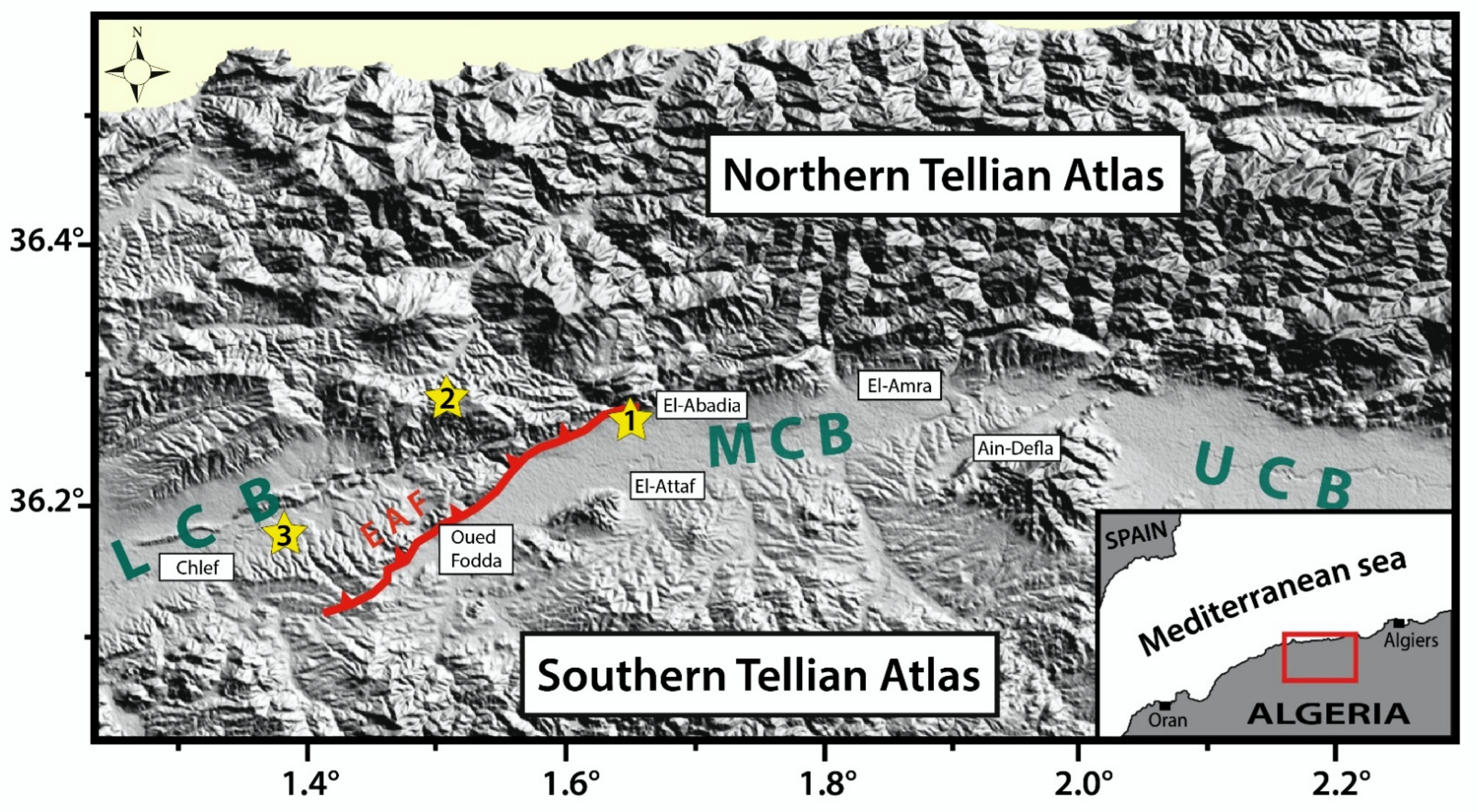
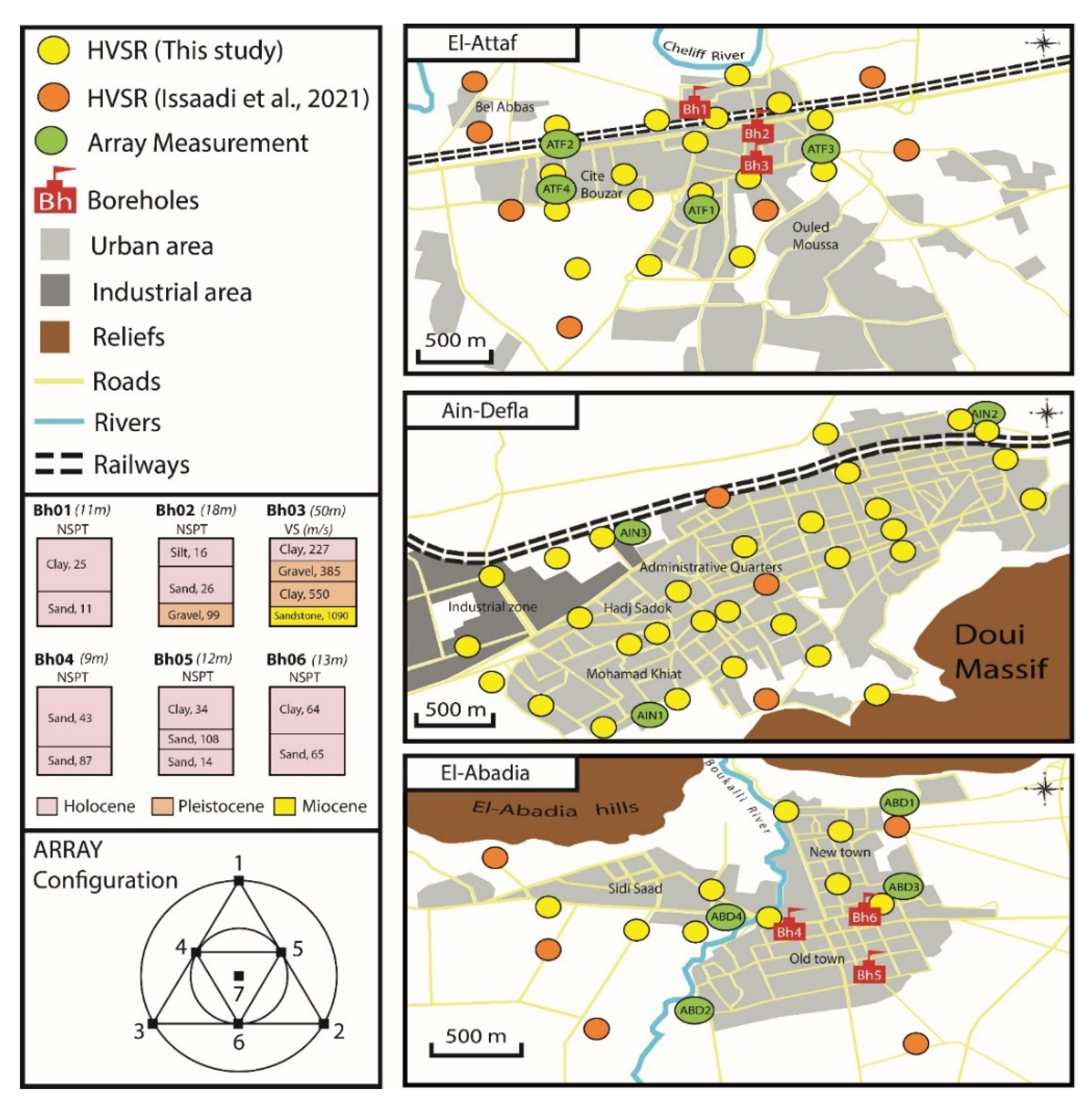
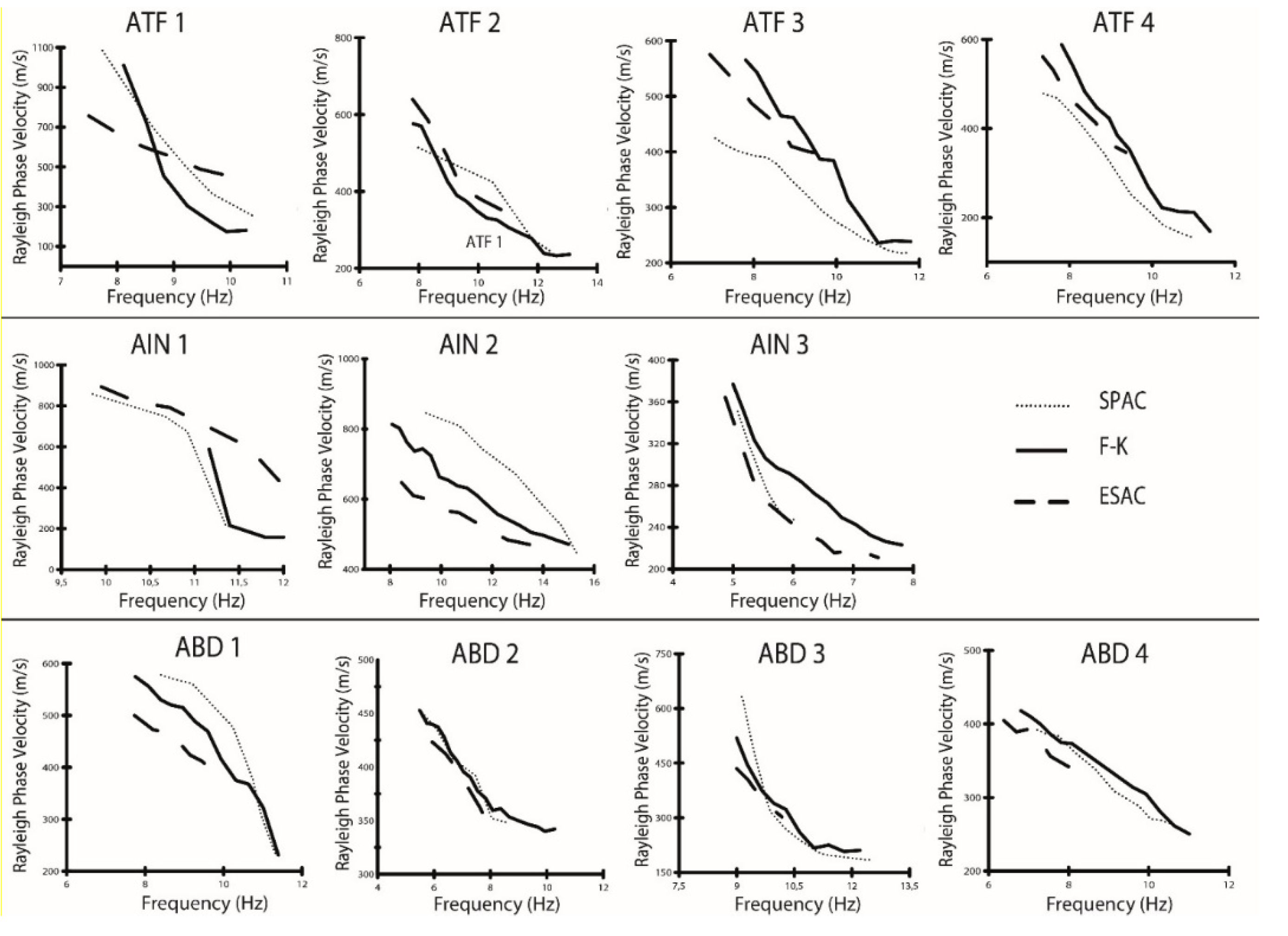
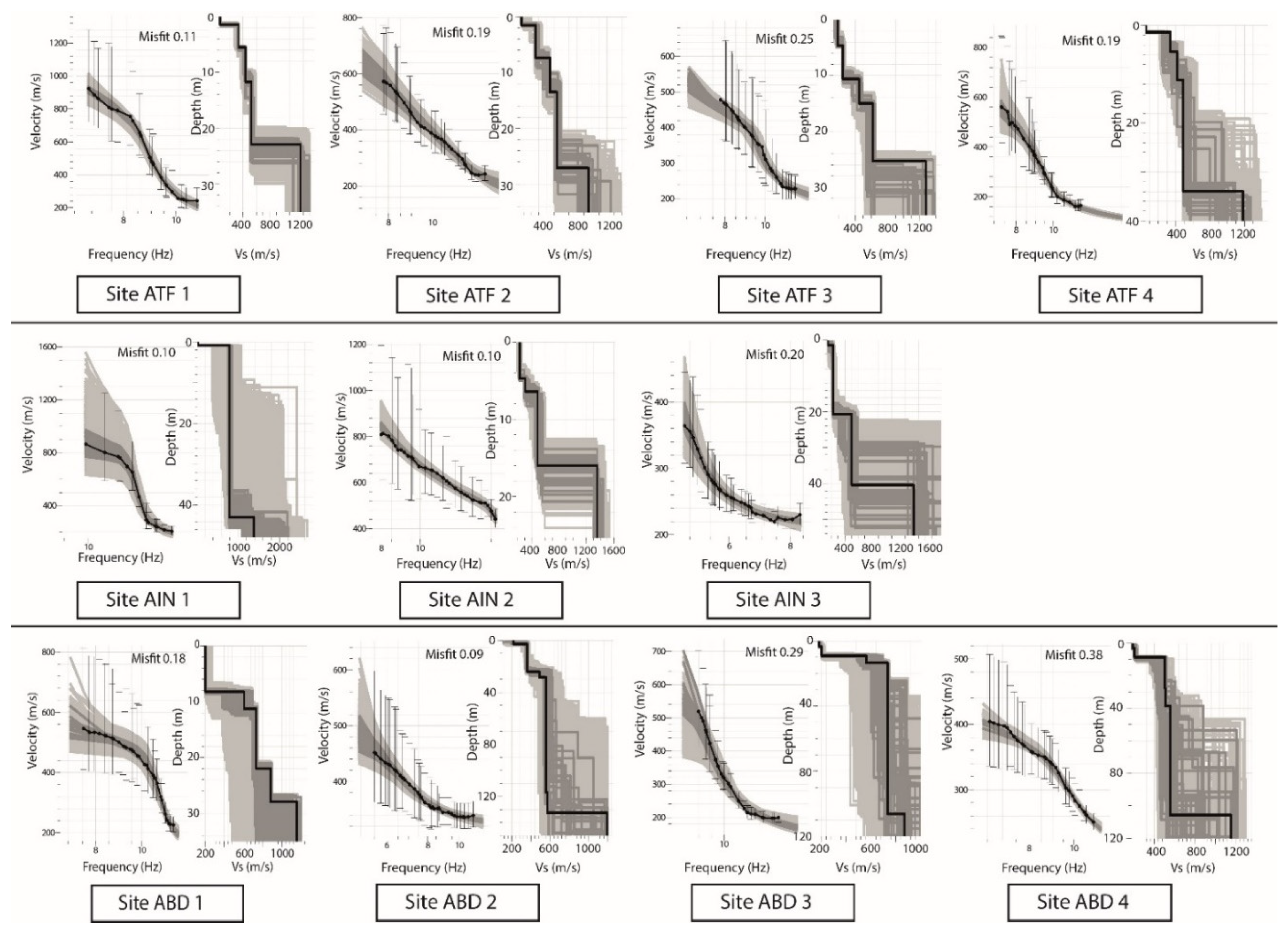
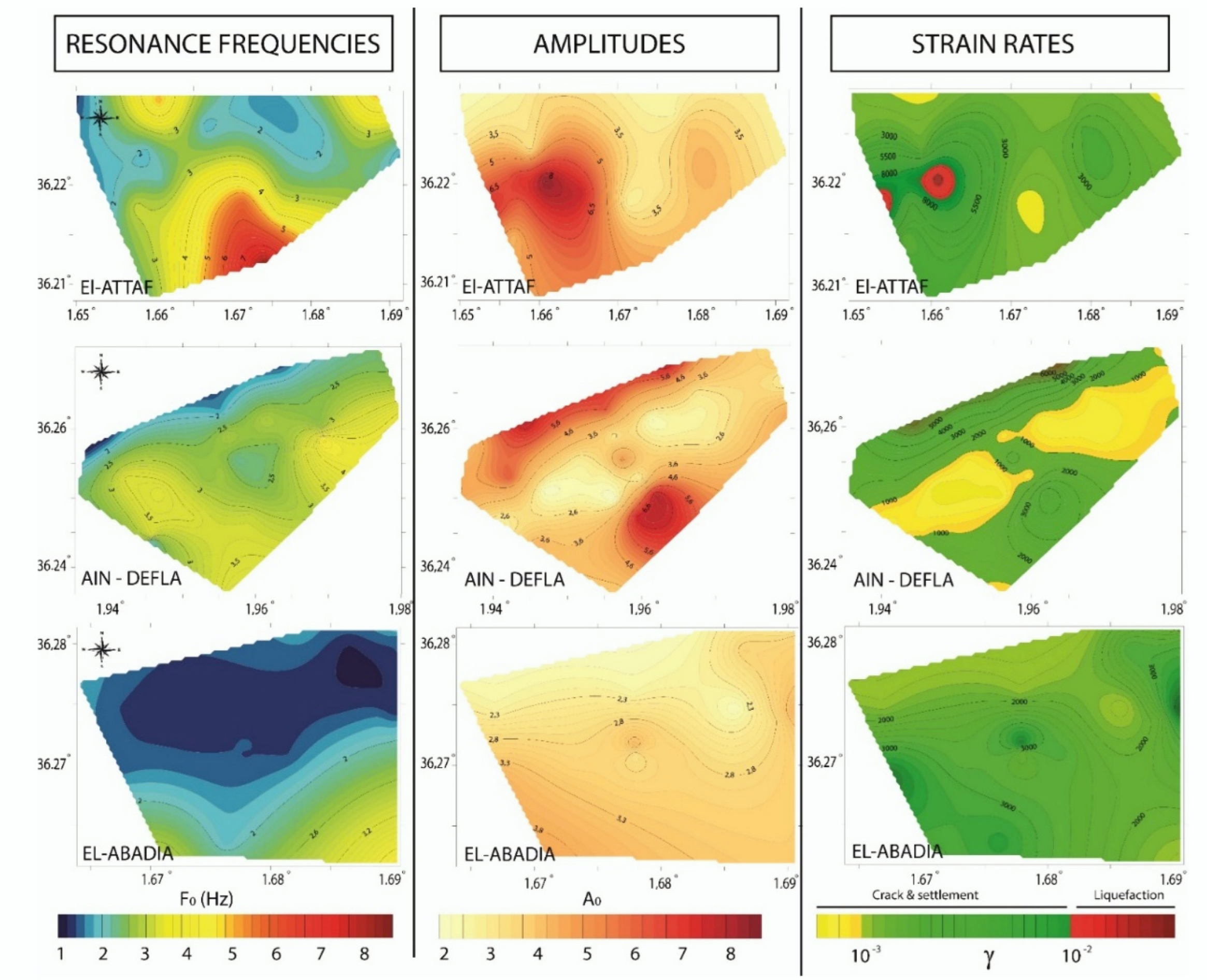
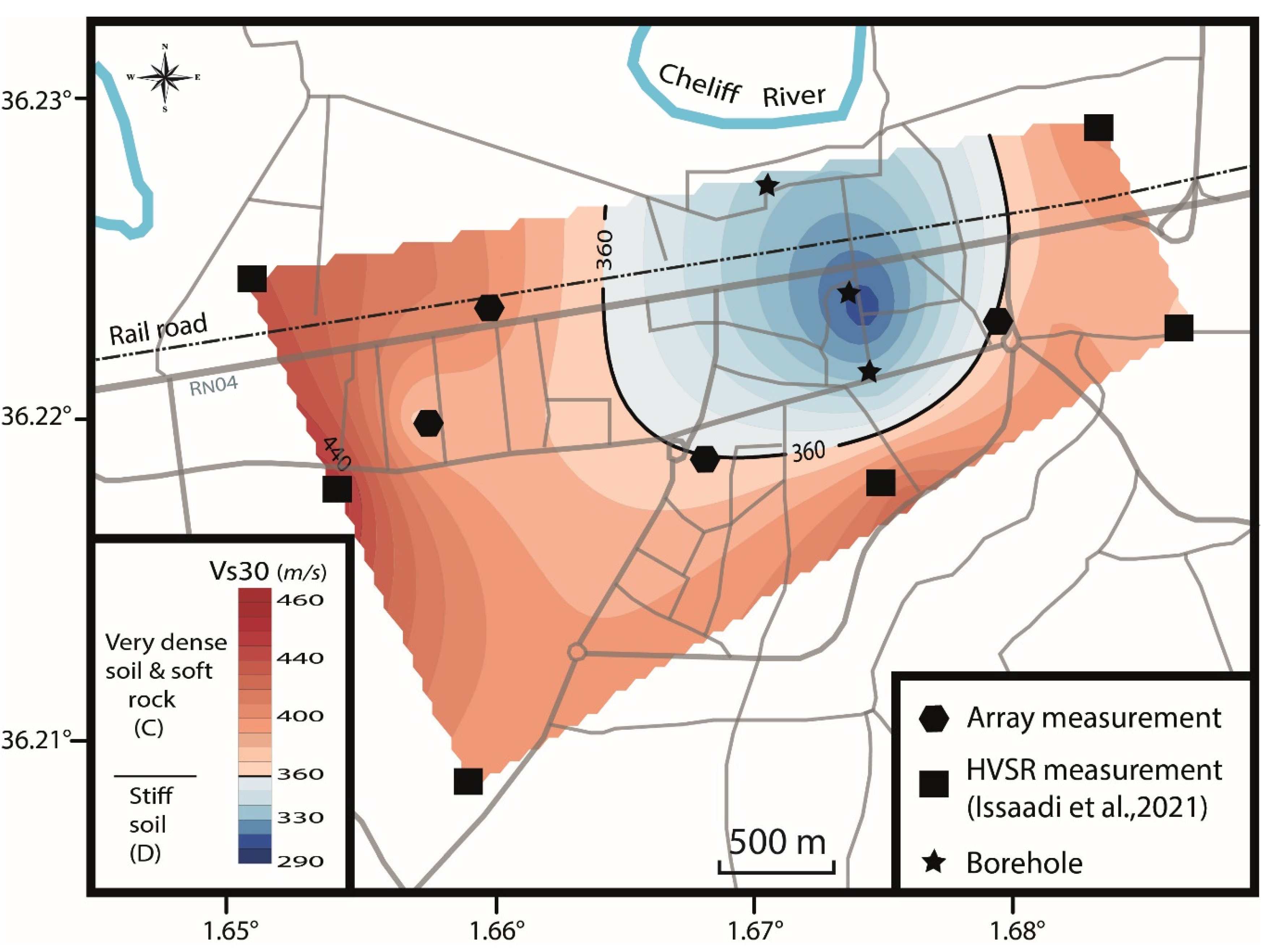
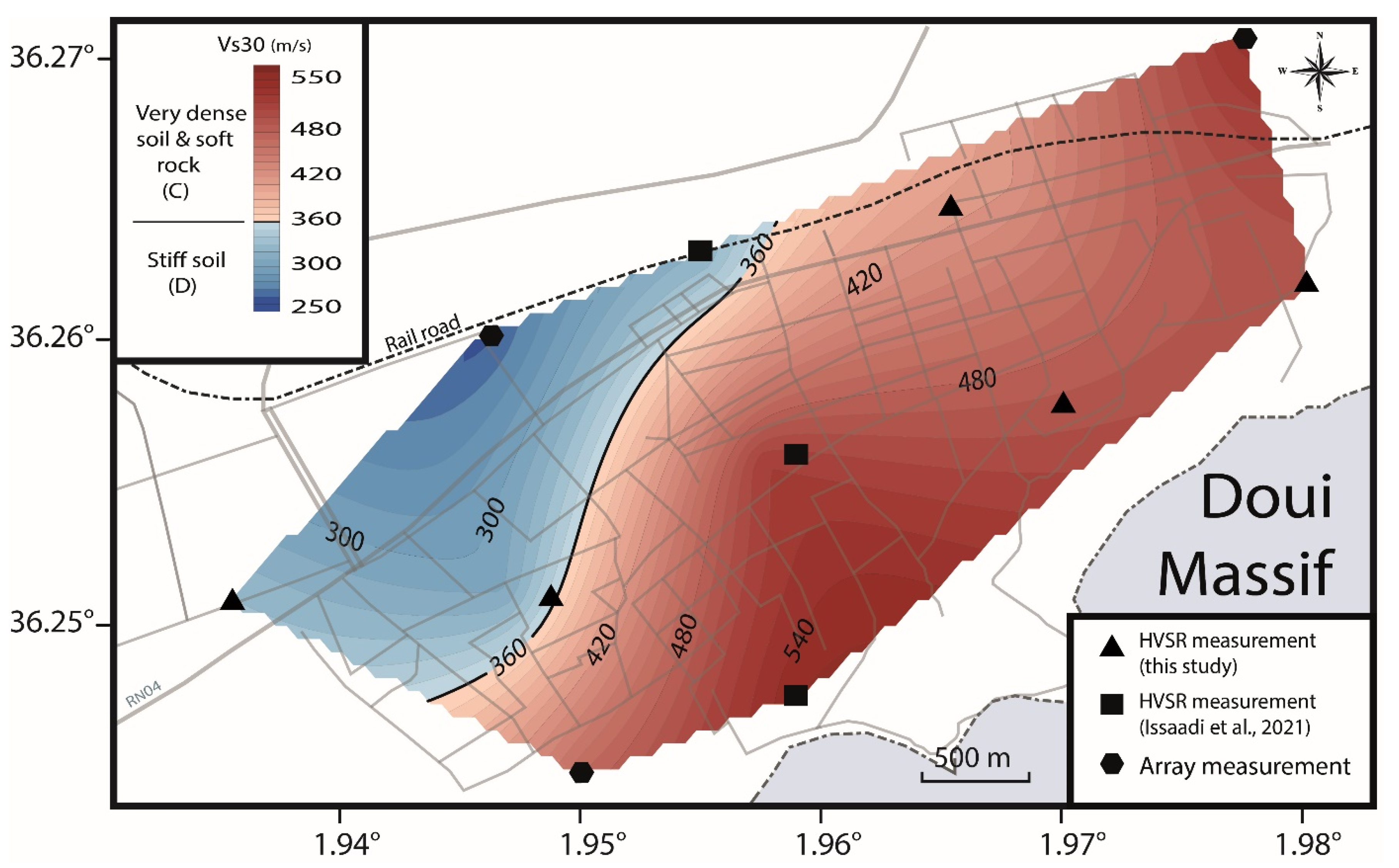
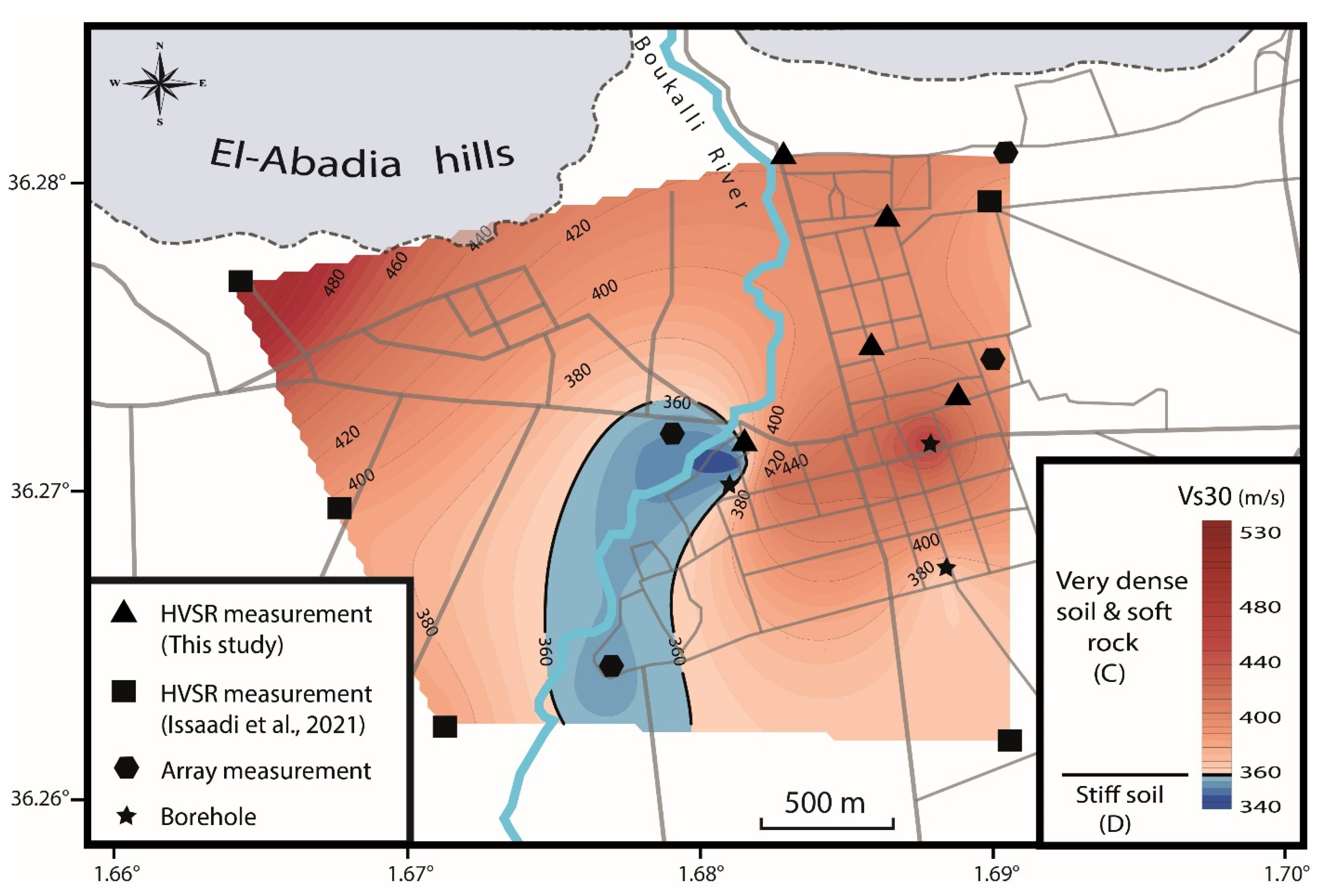
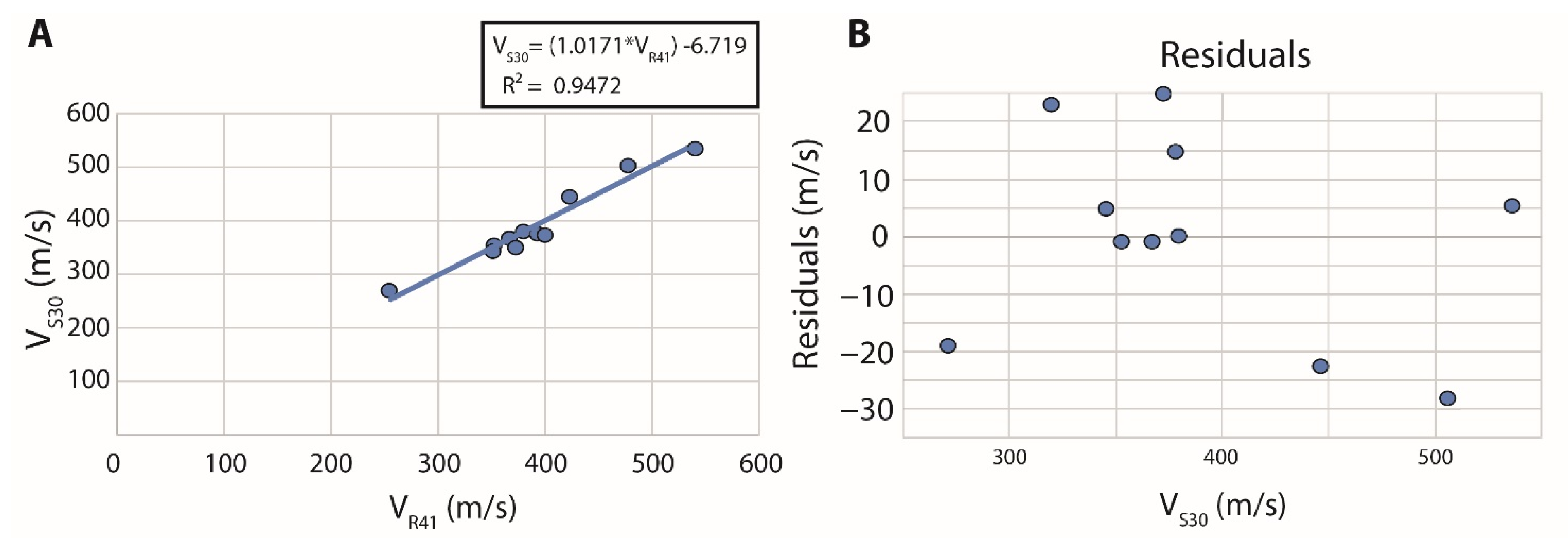
| Size of Strain Υ | 10−6 | 10−4 | 10−3 | 10−2 | 10−1 |
|---|---|---|---|---|---|
| Phenomena | Wave | Vibration | Crack | Settlement | Landslide, soil compaction, liquefaction |
| Dynamic properties | Elasticity | Elasto-plasticity | Collapse | ||
| Title 1 | Title 2 | Title 3 |
|---|---|---|
| Vs > 1500. | Hard rock | A |
| 760 < Vs ≤ 1500 | Rock | B |
| 360 < Vs ≤ 760 | Very dense soil and soft rock | C |
| 180 < Vs ≤ 360 | Stiff soil | D |
| Vs ≤ 180 | Soft soil | E |
| Site | Location. | Vs30 (m/s) | Predicted Vs30 (m/s) | Error (%) | Actual Site Classification | Predicted Site Classification |
|---|---|---|---|---|---|---|
| This study | ||||||
| ATF1 | EL-Attaf | 349.85 | 371.64 | 5.9 | D | C |
| ATF2 | EL-Attaf | 373.97 | 399.10 | 6.3 | C | C |
| ATF3 | EL-Attaf | 379.08 | 379.27 | 0.0 | C | C |
| ATF4 | EL-Attaf | 367.03 | 366.05 | 0.3 | C | C |
| AIN1 | Ain-Defla | 505.73 | 477.42 | 6.0 | C | C |
| AIN2 | Ain-Defla | 535.85 | 541.50 | 1.0 | C | C |
| AIN3 | Ain-Defla | 270.42 | 251.42 | 7.6 | D | D |
| ABD1 | El-Abadia | 445.84 | 423.00 | 5.4 | C | C |
| ABD2 | El-Abadia | 352.64 | 351.30 | 0.4 | D | D |
| ABD3 | El-Abadia | 377.57 | 392.49 | 3.8 | C | C |
| ABD4 | El-Abadia | 345.05 | 349.98 | 1.4 | D | D |
| Ref. [21] | ||||||
| AR1 | Oued-Fodda | 225.87 | 230.85 | 2.2 | D | D |
| AR2 | Oued-Fodda | 223.65 | 211.80 | 5.6 | D | D |
| AR3 | Oued-Fodda | 449.07 | 457.90 | 1.9 | C | C |
| AR4 | Oued-Fodda | 402.88 | 412.22 | 2.3 | C | C |
| AR5 | Oued-Fodda | 467.75 | 457.90 | 2.2 | C | C |
| AR7 | El-Amra | 454.45 | 469.59 | 3.2 | C | C |
Publisher’s Note: MDPI stays neutral with regard to jurisdictional claims in published maps and institutional affiliations. |
© 2022 by the authors. Licensee MDPI, Basel, Switzerland. This article is an open access article distributed under the terms and conditions of the Creative Commons Attribution (CC BY) license (https://creativecommons.org/licenses/by/4.0/).
Share and Cite
Issaadi, A.; Saadi, A.; Semmane, F.; Yelles-Chaouche, A.; Galiana-Merino, J.J. Liquefaction Potential and Vs30 Structure in the Middle-Chelif Basin, Northwestern Algeria, by Ambient Vibration Data Inversion. Appl. Sci. 2022, 12, 8069. https://doi.org/10.3390/app12168069
Issaadi A, Saadi A, Semmane F, Yelles-Chaouche A, Galiana-Merino JJ. Liquefaction Potential and Vs30 Structure in the Middle-Chelif Basin, Northwestern Algeria, by Ambient Vibration Data Inversion. Applied Sciences. 2022; 12(16):8069. https://doi.org/10.3390/app12168069
Chicago/Turabian StyleIssaadi, Abdelouahab, Ahmed Saadi, Fethi Semmane, Abdelkrim Yelles-Chaouche, and Juan José Galiana-Merino. 2022. "Liquefaction Potential and Vs30 Structure in the Middle-Chelif Basin, Northwestern Algeria, by Ambient Vibration Data Inversion" Applied Sciences 12, no. 16: 8069. https://doi.org/10.3390/app12168069








